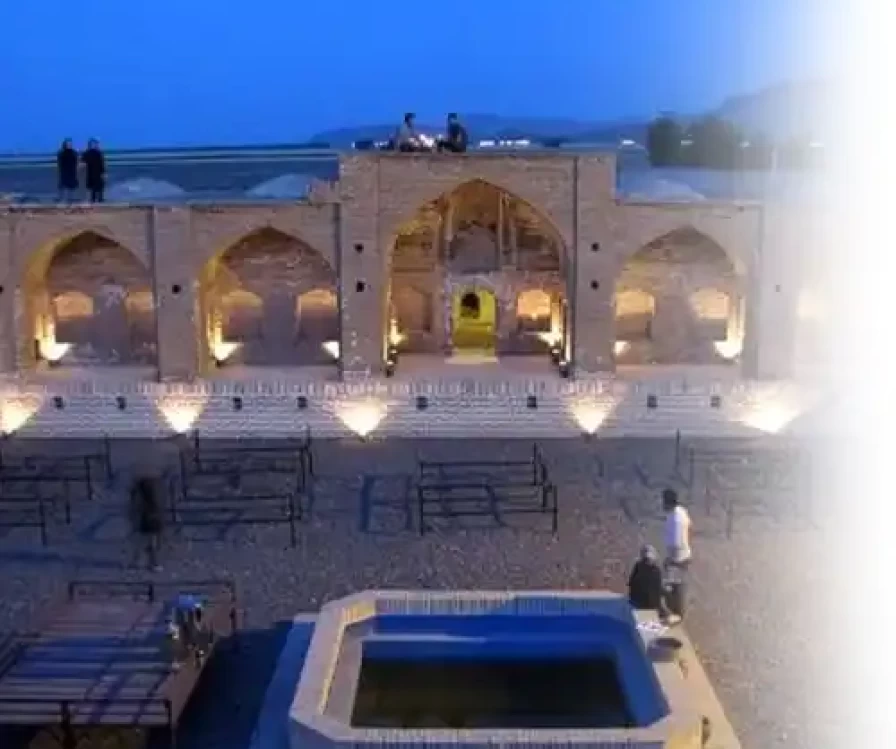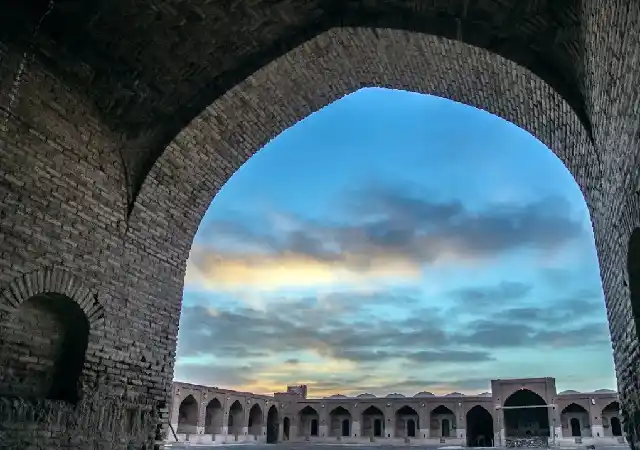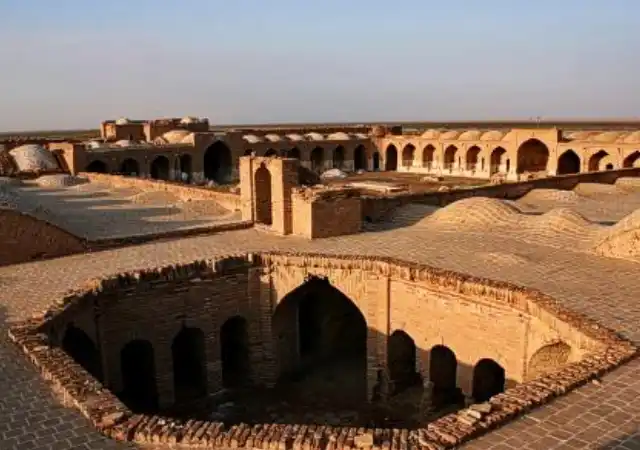
Deyr Gachin Caravanserai





Deyr Gachin Caravanserai
Many travels are needed to mature the raw. Travel is an inseparable part of human life, especially for Iranians. Due to the Silk Road, a significant portion of which passed through Iran, and the importance of trade routes, it is known that the Safavid dynasty built 999 caravanserais to serve caravans and travelers. Among them, Deyr Gachin stands out for its size, structure, and services. This caravanserai dates back to the Sassanian era and has undergone numerous renovations over the years. In many ways, this caravanserai is unique, and its size and grandeur are a testament to the economic prosperity of past centuries.
Deyr Gachin features a private courtyard, a mosque, rooms equipped with stoves, dedicated water reservoirs, several toilets, and even a bath. It is one of the few caravanserais that have been in use until recently. Located on the historical road from Rey to Qom, Deyr Gachin is currently situated in the heart of Kavir National Park. It is one of the largest caravanserais in Iran, and its unique characteristics have earned it the title of the "mother of caravanserais." Deyr Gachin is found in the central part of Qom County, about 80 kilometers northeast of Qom city (60 kilometers on the Garmsar road) and 35 kilometers south of Robat Karim. The name "Deyr Gachin" comes from its plaster dome, which has unfortunately disappeared over time. The structure of the caravanserai originates from the Sassanian period and has been restored during the Seljuk, Safavid, and Qajar eras. The current form of the building belongs to the Safavid period. This caravanserai is situated along the ancient road from Rey to Isfahan, known as the Deyr road. Following the rerouting of the road from Tehran to Qom during the Amin al-Sultan era, Deyr Gachin fell into disrepair and was abandoned, with locals using it for livestock. The building is designed in a four-iwan style from the Seljuk period and covers an area of about 12,000 square meters. The existing spaces can be divided into areas for humans, animals, and services. The structure features four round towers at the corners, with two oval-based towers flanking the main entrance, located in the middle of the southern wall. Deyr Gachin also includes 44 residential rooms, 4 large halls (stables), a mosque, a private prayer hall, fodder storage, a mill, a bath, 6 toilets, and a water reservoir outside the complex. The materials used in Deyr Gachin include bricks, lime, adobe, and plaster. The mosque is built in a four-arch style, likely on the site of a Sassanian fire temple, and shows no decorations.
Several structures surround Deyr Gachin, including two water reservoirs behind the western side near the bath, a brick kiln, a water dam, and a cemetery from the Islamic period in the southwest corner, with graves covered in bricks. About 500 meters east of the caravanserai, there is a clay building from the Qajar era shaped like a castle with only one entrance. Due to its unique position along the old Rey to Isfahan route, this caravanserai has been mentioned in many historical texts and travelogues, referred to by names such as Deyr Kordashir, Dezh Kordashir, Gardeshir Deyr Gach, Deyr Gachin, Qasr al-Jass, Deyr al-Jass, and Rabat Deyr Gachi. The construction of Deyr Gachin is attributed to Ardeshir Babakan, which is why it is named Kordashir, meaning "built by Ardeshir." Later, this building was renovated by Anushirvan.
Deyr Gachin is located in the center of Kavir National Park and is recognized as the mother of caravanserais in Iran due to its size and grandeur. This building was constructed along the ancient road from Rey to Isfahan and held strategic importance. The location of Deyr Gachin on the ancient Rey to Isfahan road has long been a hub for communication between the East and West, with routes from the northern, western, southern, and eastern regions converging at this point. During the Medes and Achaemenid periods, this location facilitated connections between the eastern provinces and the south and west, holding defensive significance. During the Seleucid, Parthian, and Sassanian periods, the commercial importance of this site increased, and it became part of the Silk Road, extending from Ctesiphon to Balkh, Samarkand, and Bukhara. This route began in the capital of China (Xi'an) and passed through Khotan and Kashgar to Rey and Deyr Gachin, from where it continued to Antioch on the Mediterranean coast. This road was also part of the route to Khorasan, which served as a commercial path and pilgrimage route during the Islamic period. According to Yaqubi, the roads to Rey, Isfahan, Karaj, and Hamadan branched off from Qom, and without the Deyr Gachin caravanserai, crossing the desert between Rey and Qom would not have been possible. This route has been known as the Deyr road since the Safavid era.
The road became abandoned in 1246 AH with the construction of the new route from Tehran to Rey and Qom (Hassanabad). After the abandonment of the Deyr road, the Deyr Gachin caravanserai was also forgotten. Deyr Gachin is situated in a dry desert climate. The days in the desert are extremely hot and exhausting, while the nights are very cold. The annual rainfall in this area is only 40 to 50 millimeters. The only plants that can survive in this climate are those adapted to dry regions, such as tamarisk and saxaul. The soil is saline, making agriculture impossible. Due to the presence of saline basins, fresh water has risen to the surface layers, contributing to the erosion of the foundations of Deyr Gachin. The rivers Karaj, Shour, Qareh Chay, and Qom Rud flow through this area, but unfortunately, they are also saline.
The caravanserai is a square building measuring 109 by 108 meters, covering an area of 12,000 square meters. In the four corners of the building, there are four towers with circular cross-sections, and two oval-based towers are located on either side of the main entrance, situated in the middle of the southern wall. The design of this building follows a four-iwan style and includes 44 residential rooms, 4 large halls or stables, a mosque, a private prayer hall, fodder storage, a mill, a bath, and toilets. The materials used in Deyr Gachin include lime, brick, adobe, and plaster. Stone was only used in the mill, the mosque's mihrab, and above the entrance gate, which no longer exist. No wood was used in this building, and the chambers lack doors and windows. The entrance gate was likely wooden, but no trace of it remains. The outer walls and towers are very thick, about 3 meters thick. These walls are quite resilient and have lasted to this day. The inner courtyard is square, measuring 69 by 69 meters, covering an area of over 4,700 square meters, with an iwan and ten chambers built on each side. Each chamber has a small iwan, approximately one to one and a half meters high, designed for the ease of boarding and disembarking travelers. Service spaces are located in the four corners of the building. In the right corner of the southern side is the mosque, and in the right corner of the northern side is the private prayer hall. In the left corner of the southern side is the bath, and in the left corner of the northern side are the fodder storage and the mill.
The iwan or main entrance on the northern side of the building is more elaborate than the other iwans, and behind it is a corridor with three chambers. Behind the rooms on each side, there are stables designed as long corridors with vaulted ceilings, connecting to the courtyard through two exits. In the northeast corner of the building, there is an independent prayer hall with an octagonal courtyard. This structure, with its special design and complete facilities, is considered the most luxurious part of the caravanserai. In the right corner of the southern side, a mosque measuring 15.5 by 15 meters has been built, featuring 4 columns measuring 1.5 by 1.5 meters. This building resembles the four-arch structures of the Sassanian period, which is believed to have originally been a fire temple or a four-arch structure, later converted into a mosque after its dome was removed.
This caravanserai is one of the few that includes a bath and toilets. The bath consists of spaces such as a changing room, a hot room, and two pools with vaulted ceilings. Next to the bath is a square courtyard that leads to the bath and connects to one of the stables, which may have served as a kitchen. Although the overall structure of the bath is Sassanian, evidence suggests that the bath's vault was constructed in the early Islamic years, and this design was reused during the Qajar period.
This building also has other spaces such as livestock holding areas, a mill for grinding wheat, and security spaces, which are unique in their own right. Outside the caravanserai, there is another clay caravanserai built during the Qajar period. Another notable feature of this caravanserai is the presence of two water reservoirs for collecting and storing water. According to ancient sources, there was also a well in the center of the caravanserai, all of which contributed to supplying water for this massive structure. This building has been used during the Seljuk, Safavid, and even Qajar periods and has undergone numerous renovations and restorations. After the road from Tehran to Qom changed during the Amin al-Sultan era, it became abandoned, and locals used it to keep livestock until it underwent emergency restoration in 1382 and was reasonably restored by 1385. It is currently under restoration by the Cultural Heritage and Tourism Organization. This building is recognized as one of the most remarkable historical sites in the region and Qom province. We hope to meet you soon in Iran, Qom province, Deyr Gachin. We, as the Sana Persian team, aim to present this historical site in the best possible way and be excellent hosts for you. Looking forward to that day!
Contact Us
+989054577261